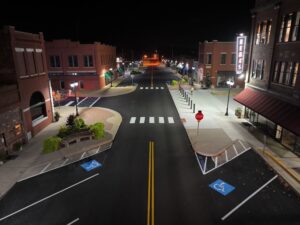Types of Dallas Parking Lot Layouts for Efficiency and Safety

Why Are Safety and Efficiency Important for Dallas Parking Lot Layouts?
In parking lot layouts, safety and efficiency drive each other to enhance each aspect. In other words, an efficient parking lot is safer, and a safer parking lot is more efficient. If your parking lot layout confuses or frustrates drivers, accidents can increase. However, if a parking lot layout in Dallas makes it easy for drivers and pedestrians to navigate through the lot, safety is enhanced. When a parking lot layout does not cause safety issues, traffic can flow through it more efficiently, leading to fewer areas of congestion.
What Are the Primary Considerations for Safe and Efficient Dallas Parking Lot Layouts?
The most critical step you need to take is to locate a trustworthy, experienced parking lot layout contractor. Professional parking lot layout companies have access to a variety of products, including design apps and other software, that allow them to model different scenarios to find the solution that matches the client’s needs. Here are some of the points that a parking lot layout company will assess when creating or modifying a design.
1. Parking Angle: The angle at which cars park affects the number of stalls that can be created as well as the width of the travel aisles. Head-in parking spaces have an angle of 90 degrees, which makes them slightly more challenging for drivers. Therefore, it is often reserved for situations where cars will remain parked for extended periods. If you are providing parking for your employees, or your parking lot serves an educational facility, this angle might work for you. On the other hand, if cars are frequently coming and going, an angle of 30, 45, or 60 degrees might be better. In general, the closer the parking angle is to 90 degrees, the greater the number of stalls that can be created in the same square footage. However, the parking angle can also impact the efficiency and safety of your lot. Drivers who have difficulty entering head-in spaces can delay traffic, and they may accidentally scrape against a neighboring car.
2. Travel Aisles: Travel aisles can allow traffic to flow in both directions or just one. One-way travel aisles do not need to be as wide as two-way aisles. Regardless of whether they are one-way or two-way aisles, the parking angle can also affect the required width. For example, because drivers need a greater turning radius to enter head-in parking stalls, the width of the travel aisles may need to be adjusted accordingly.
3. Accessibility: The Americans with Disabilities Act applies to virtually every parking lot owned or operated by a private or public business, organization, or agency. Based on the total number of stalls contained in the parking lot, the ADA dictates how many must be designated as accessible spaces. The number of accessible spaces is divided between car- and van-accessible spaces. The ADA also states where accessible spaces must be located, and it gives the minimum dimensions for the spaces and their adjoining access aisles. Furthermore, the ADA provides rules pertaining to the accessible routes that connect these spaces to the nearest accessible entrance to the building.
4. Users: The dimensions of your individual parking spaces can depend on how your parking lot is used. For example, if you operate a retail store that allows customers to transport their purchases from your front door to their vehicles in a shopping cart, you might want to ensure that your spaces are large enough to allow customers to transfer their loads easily. If a high percentage of your lot’s users ride motorcycles or drive subcompact cars, you could consider making some of your spaces a bit smaller.
5. Features: Few parking lots are unbroken expanses of pavement. The features you need or want can affect your parking lot layout. Some of the features that your parking lot layout company may need to consider include light poles, landscaping islands, and cart corrals.
As you can see, there are many details involved with the creation of safe and efficient Dallas parking lot layouts. If you would like to explore the topic in greater detail, contact Advanced Texas Striping for assistance. We specialize in parking lot striping, parking lot layout, ADA compliance, parking lot re-striping, and warehouse striping for customers in the DFW metroplex. We are known for our integrity, reasonable rates, and high-quality work. If you are interested in a free quote, you can submit your request by filling out our online form. If you prefer, you can call 817-600-5975, or you can send an email to Mark@ATStriping.net.
